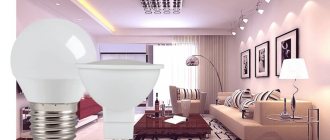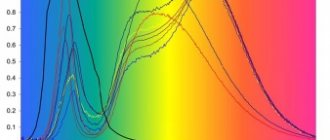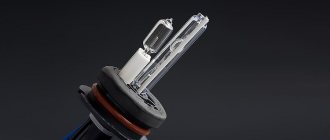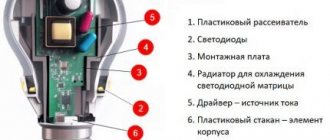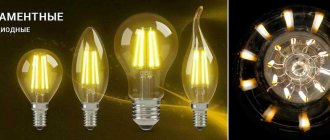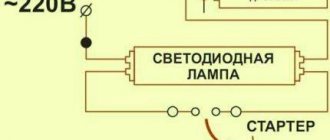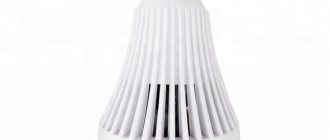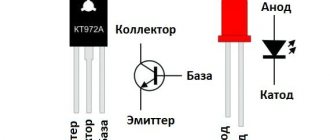LED characteristics
The practice of LED lights gradually replacing traditional incandescent or halogen lamps is a growing trend in various areas. However, a consensus on the effect of using LED devices in the scientific community has not yet been developed. Some experts claim that LED devices screwed into a chandelier have a negative effect on the eyes, while opponents are confident of a neutral effect. Motorists have their own reasoning.
The disadvantages of using LEDs are their rather high cost, which is 10-20 times more than the price tag of incandescent lamps. Also, such optics will require a rated current, for which it will be necessary to install a resistor or new current sources in the circuit.
The disadvantages are compensated by the advantages obtained:
- The service life of LEDs, according to manufacturers, is several times higher than traditional incandescent lamps;
- a wide range of operating conditions, which allows you to effectively operate devices in the range from -30 C to +70 C;
- significantly less heat is generated due to increased efficiency;
- power consumption is several times lower with equal luminous flux output to traditional devices.
Experts have calculated that the response speed of LEDs is 200 ms higher than classic lamps. This fact is relevant when operating light optics in rear lights. The driver driving behind such a car will have time to notice the “stop” light a few hundredths of a second earlier. This fact will be reflected in a reduction in braking distance and can ultimately prevent accidents .
Is it possible to install LED lamps on cars?
Current rules regulate the use of diode optics for low and high beam lighting. According to these facts, legality is recognized in the following cases:
- The LED elements were installed at the automobile manufacturer. There is no need to be afraid of fines in such cases. Competent inspectors have information about the brands of cars with such headlights.
- Automotive companies have switched to producing cars of this brand and model with LED optics, although previously halogens were installed in the headlights. In this case, all lighting fixtures used correspond in brand, class, power, and type of reflectors to the one used at the factory.
However, some car drivers convert them themselves. At the same time, they have to interfere with the design of the vehicle.
H4 lamp circuit
First of all, you need to take into account that, by law, LED lamps can only be installed in headlights marked “LED” or “L”; it is applied to the reflector or is on the body. If the system is designed for halogen, installing diode light sources may entail a fine of 500 rubles.
LED bulbs provide quality light when installed correctly.
If the design is suitable, it is important to select an LED lamp with the correct light distribution. In this version, two spirals are used - low and high beam. Moreover, the first element is always equipped with a small reflector of a certain configuration, as in the example in the photo.
This is what a standard H4 light bulb looks like.
To ensure proper distribution of light output and prevent dazzling oncoming drivers, the low beam spiral is positioned forward slightly above the focal point. And the screen inside the bulb directs light only to the upper part of the headlight reflector, as shown in the diagram.
This is how the low beam from the H4 lamp should be distributed.
The high beam is different, its spiral is located at the focal point and shines on the entire reflector. This ensures a greater lighting distance.
Installation instead of halogen lamps
Without understanding whether LED lamps are prohibited in cars, some motorists independently look for such optics with suitable sockets and reinstall the devices. As a result, the light becomes much brighter and prettier. But everyone knows that there is a violation of the Traffic Rules and a violation of the current Code of Administrative Violations.
Clause 3.1 of the Traffic Regulations contains a complete list of faults for which it is prohibited to operate the vehicle on public roads. Among them there is not only color, quantity and operating mode, but also the “type” of the lighting device that does not correspond to the design.
The Administrative Code provides for punishment, according to Part 3, when the operating mode of lighting devices does not meet the requirements. The driver has the right to deprive his license for a period of six months to a year. Not everyone knows why you can’t install LED lamps on cars.
It is important to know that the main reason for banning LEDs in cars is the mismatch between the type of lamp and the type of reflector, so legalizing such a pair with a simple replacement will not work.
Is it possible to install LED and LED lamps yourself?
The driver has the right to dismantle halogen devices and replace them with LED analogues, but only in compliance with technical regulations. If you decide to replace a halogen car light with an LED one and not get a fine for it, you must:
- Submit an application to the traffic police notifying you of your desire to replace the vehicle lighting with LED lamps. Once you have received the official agreement, you can proceed with the replacement. In case of refusal, the driver retains the right to apply for a second permit through the court.
- Conduct a technical examination for vehicle re-equipment, which will issue a conclusion on the possibility of making changes to the design.
- Upon completion, send the car for technical inspection, where, after the necessary checks for compliance with technical safety, receive a certificate and permission to operate the vehicle.
The key document that regulates the procedure for self-installation of LED lamps is the Appendix to the Federal Law “On Police” dated November 20, 2015 on “Methodological recommendations for organizing verification of compliance with the requirements for vehicles in use in the event of changes in their design.”
Also, the conversion procedure is reflected by the Federal Law of December 10, 1995 N 196-FZ “On Road Traffic Safety” and the Administrative Regulations of the Ministry of Internal Affairs of the Russian Federation “On the provision of public services for making changes to the design of vehicles in use.”
Installation of LEDs and LEDs is legally possible only in headlights certified by the manufacturer, equipped with a washer and auto-corrector, taking into account the installation of bulbs suitable for the type (each light source is marked in accordance with its use in certain headlights, so non-compliance will be considered a violation).
It will not be difficult for a traffic police officer to determine the type of installed headlights (the manufacturer's markings are indicated on the glass), therefore, when installing uncertified devices, the driver falls under clause 3.1 of the Traffic Regulations and Art. 12.5 of the Code of Administrative Offenses of Russia, according to which the operation of the vehicle is prohibited due to malfunctions. For violating the law, the driver may receive a fine or lose his driving license for a period of 6 months to 1 year.
Legal use of diodes in lighting
During the usual change of halogens to LEDs, the inspector has the right to impose a fine of 500 rubles, but the driver has a legal option to legalize the new product. In this case, you will need to obtain a certificate of conformity of the vehicle with the changes applied to the design that meet the safety requirements.
To do this, you need to go to the traffic police to re-register the car. This way you will be able to avoid punishment and not pay fines. It’s easier for those drivers whose cars the automaker began installing LEDs on its own for the later model range. In such a case, a safety check is not required, which is stated in the regulations of the Customs Union.
To fully comply with the conditions of the traffic police, headlights from a similar new model must be installed on the car. After all, inside there will be reflectors that comply with regulatory regulations. Therefore, before properly installing LED lamps on a car, it is necessary to install a new headlight, which will eliminate complaints from law enforcement officers.
Can LED bulbs be installed in regular headlights?
UPDATE
Excerpt from document:
“The objective side of the relevant administrative offense can only occur in the event of a simultaneous discrepancy between the color of the lights and the operating mode of such devices with the requirements specified by the manufacturer in the operational documentation, and in cases where additional lighting devices are installed.”
“However, if only the color or operating mode of the light devices installed on the vehicle does not comply with the above requirements, driving such a vehicle may be qualified under Part 1 of Article 12.5 of the Code of Administrative Offenses of the Russian Federation.”
Have you noticed how LEDs have smoothly and imperceptibly entered our lives? They are everywhere. They are everywhere. But just a few years ago, LED optics seemed fantastic. Especially in the auto industry. True, now, every year, more and more automakers are installing LED headlights on their cars instead of standard halogen or xenon optics. This became possible due to the fact that the cost of LED lamps has dropped significantly.
As a result, a widespread fashion for LEDs came into the world and immediately a demand for LED optics appeared in the auto world. But not everyone can afford to buy a new car with LED headlights. Therefore, many companies realized that the time has come to produce LED lamps for low and high beams, which can replace conventional halogen and xenon lamps in headlights. Naturally, many car enthusiasts decided to purchase similar lamps for themselves and install them on their cars. But is it legal? And is there any liability for installing non-factory LED optics? Let's figure it out.
Technologies of the 21st century are increasingly taking over our world. Every year more and more incredible innovative ideas appear, and yesterday’s fantastic technologies are becoming a reality today. The progress of the digital age has not spared the auto industry. Especially car lighting devices, which have undergone significant changes over the past decades.
Moreover, progress in auto lighting technology over the past few years has become more significant than over the past 50 years. As a result, we saw how xenon optics first appeared in the automotive industry. Then, LED. Now the world is on the threshold of a new era - laser light illumination.
But today we are not talking about that. As we have already said, all over the world (including in our country) LED lamps that are installed in car headlights are currently becoming extremely popular.
In recent years, more and more drivers are beginning to think about replacing halogen and xenon headlights with LED ones. How effective is it, etc. you can find out from our review article here.
But there is one main question that worries many. Is it possible to install new-fangled LED lamps in conventional headlights designed for halogen or xenon lamps? Is there liability in Russia for installing LED lamps in front optics?
Unfortunately, many car owners think that liability does not exist. After all, these are not xenon lamps, which are prohibited from being installed in halogen headlights. But that's not true. Responsibility actually exists and is very strict. For example, for illegally installing LED low-beam or high-beam lamps in the front optics, the driver may lose his driver's license. Surprised? Here are the details.
Why do many drivers believe that there is no responsibility for installing LED lamps?
Indeed, an interesting paradox has developed in our country. For example, most drivers know that in Russia there is liability for installing xenon lamps in halogen headlights in the form of deprivation of a driver's license. That is why we no longer see a lot of cars on the road with “collective farm” xenon. After all, you must agree that the responsibility for the illegal installation of xenon lamps is very severe.
But why then, every year, more and more cars with LED lamps appear on Russian roads, which are usually installed by vehicle owners themselves?
What is the responsibility for installing LED lamps in halogen or xenon headlights?
Installing LED low or high beam sources in the front halogen or xenon headlights is equivalent to equipping the car with red special signals. Accordingly, according to the current traffic rules and the Code of Administrative Offenses of the Russian Federation, if a driver illegally and unauthorizedly installs LED lamps in headlights intended for halogen or xenon lamps, he faces liability in the form of deprivation of his driver’s license for up to 1 year.
Agree that this is a very strict measure. Also, do not forget that ignorance of the laws does not exempt you from responsibility. Therefore, under no circumstances should you install LED bulbs on your car in headlights that are not designed for this purpose according to the factory specifications.
Someone might think that the above link to Article 12.5 Part 3 does not directly prohibit the installation of LED lamps in halogen or xenon headlights. But that's not true.
Article 12.5 Part 3 of the Code of Administrative Offenses of the Russian Federation refers us to the provision on the basic requirements for the admission of vehicles to operation and the duties of officials to ensure road safety, for violations of which the driver may be held administratively liable.
So, in particular, according to paragraph 3 of the regulations on the basic requirements for the admission of vehicles to operation and the duties of officials to ensure road safety, the technical condition and equipment of vehicles involved in road traffic, insofar as they relate to road safety and environmental protection environment, must meet the requirements of relevant standards, rules and guidelines for their technical operation.
Accordingly, if a vehicle does not meet the relevant standards, its operation on public roads is prohibited.
According to the list of faults, the operation of vehicles with the type, color, location and operating mode of external lighting devices that do not comply with the design requirements of the vehicle is prohibited.
Here is an excerpt from the law:
List of faults and conditions under which the operation of vehicles is prohibited
3. External lighting devices
3.1. The number, type, color, location and operating mode of external lighting devices do not meet the requirements of the vehicle design.
Note: On discontinued vehicles, it is allowed to install external lighting devices from vehicles of other makes and models.
3.2. Headlight adjustment does not comply with GOST R 51709-2001.
3.3. External lighting devices and reflectors do not work in the prescribed mode or are dirty.
3.4. Light fixtures do not have lenses or use lenses and lamps that do not match the type of light fixture.
3.5. The installation of flashing beacons, the methods of their fastening and the visibility of the light signal do not meet the established requirements.
3.6. Lighting devices with red lights or red light reflectors are installed at the front of the vehicle, and white ones at the rear, except for reversing lights and registration plate lighting, reflective registration, distinctive and identification signs.
Normative base
Formally, regulatory documents do not articulate the concept of “LED lamps” (as well as xenon lamps, the nature of the ban on which is identical to diode sources). However, the use of automotive LED lamps is limited by Part 3 of Article 12.5 of the Administrative Code, which reports non-compliance with the design requirements of the car in terms of the number, type, color, location and operating mode of external lighting devices, referring to paragraph 3.1. Russian traffic rules.
Judicial practice suggests that in most cases, traffic police officers are guided by Article 12.5 of the Code of Administrative Offenses when issuing a fine for LEDs and led lamps on the car owner. The punishment includes deprivation of the driver's license for a period of 6 months to 1 year, as well as confiscation of LED lamps due to their non-compliance with established requirements.
How will the traffic police check what type of headlights your optics belong to?
Each headlight in a car must be marked at the car plant with the corresponding generally accepted marking, which indicates not only the type of optics, but also the type of lamps used in it.
Accordingly, based on the markings, technical inspection staff can determine that your car has halogen headlights, in which you, for example, installed xenon or LED lamps. Naturally, halogen optics with reflectors cannot provide safe lighting on the road when using LED lamps. That is why, according to the law, for the illegal installation of LED or xenon lamps in halogen optics, a driver can be held administratively liable (deprivation of rights).
The same applies to installing LED lamps in xenon lens optics. That is, even despite the presence of lenses in the front optics that are designed for xenon lighting sources, the use of LED lamps in such headlights is dangerous and accordingly prohibited by current legislation.
When is a fine applied for installing LED lamps?
If a traffic police inspector discovers a discrepancy with the original equipment of the vehicle, the driver risks receiving a fine of 500 rubles for the illegal installation of LED lamps. The exception to issuing a fine is in cases where the LED headlights fully meet the factory parameters of the car or the owner has received written permission to use the converted vehicle.
Let us remind you that the collection procedure is regulated by Art. 12.5 part 1 of the Code of Administrative Offenses of Russia, where LED optics are defined as a malfunction, which imposes a ban on operating the car as faulty. In this case, the driver receives a fine of 500 rubles. With rare exceptions, the inspector issues a warning before issuing a fine.
How to legally install LED bulbs in headlights?
According to the law, if you make changes to the design of the car, then you have the right to operate the car on public roads only after going through a certain procedure in legalizing the installed equipment in the traffic police and in specialized organizations.
We discussed in more detail how to formalize the conversion of a car in the article “Fine for gas equipment in a car.” Let us recall that in this article we examined the process of legalizing the installation of gas equipment on a vehicle.
When installing LED lamps in a car, you will first need to re-equip the headlights in a specialized organization, which will install the appropriate lenses and other equipment in them that will provide the LED lighting with an optimal beam of light projected onto the road.
Also, to legally register LED optics, you need to obtain permission to re-equip the car.
In particular, after installing / altering the headlights in a specialized organization, you must register the re-equipment of the car with the State Traffic Safety Inspectorate and obtain a certificate of compliance of the vehicle with the changes made to its design in accordance with safety requirements.
Read more about the process itself here.
Installation in headlights
Installation of H4 LED lamps in headlights follows step-by-step instructions. If you follow the correct sequence and do everything carefully, you can get the job done, even if this is done for the first time:
- The rear part of the headlight housing and the location of the covers are inspected. Very often, access is limited due to vehicle components - battery, air filter housing, etc. In this case, you need to remove everything that interferes to ensure normal working conditions.
- The battery terminal is removed before starting work. This rule should always be observed when you need to do something in the electrical equipment of the car. The necessary tools are being prepared; screws or small nuts often need to be unscrewed; other devices may also be required.
- The location of the lamp installation is inspected. Most often, it is fixed with a mounting bracket, which tightly presses the base to the seat. It is important to figure out how to open it so as not to break the wire protrusions or deform them.
The light bulb should be removed carefully so as not to damage the bulb or break the retainer. - After removing the old light bulb, disconnect the connector; to do this, you need to carefully pull it towards you to remove the contacts. Sometimes, due to long use, moisture and constant heating, the terminals oxidize and are difficult to remove. In this case, you can treat the connection with contact cleaning compound and carefully pry the joint off with a flat-head screwdriver.
The easiest way is to remove the clamp and secure it separately for easier installation. - It is advisable to remove the mounting plate from the LED lamp; usually it is simply turned a little and removed. It’s better to put it separately, it’s much more convenient. The element is fixed with a latch, after which you can insert the light bulb and turn it slightly to secure it in the correct position.
- Typically the lamp connector is located on a small wire with the power supply. This simplifies installation, since the elements can be connected from the outside. Everything is simple here, the main thing is to insert the contacts all the way, after which you need to select the location of the wire, it is best to put it inside the headlight. If this is not possible, the block with the connector is placed outside and secured with a plastic tie or double-sided tape.
- The lid must be put in place so that it fits tightly. After this, the process is repeated on the second headlight.
In some models, the headlight can be removed entirely; to do this, you need to release the clamps or unscrew the fasteners. There are also options when you need to remove the wheel, since access to the lamp is through a hatch in the fender liner.
Video tutorial: Replacing an H4 lamp with an LED one in a Hyundai Solaris.
